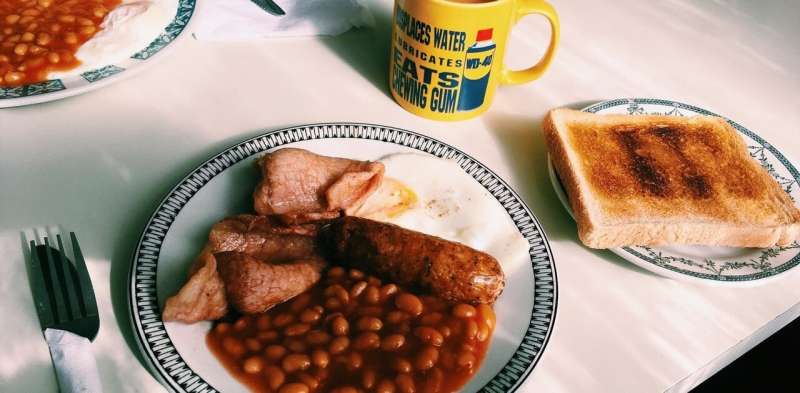The carbon footprint of a full English breakfast, and how to reduce it

Over of the English population say they enjoy a full English breakfast. But when food production accounts for a of global greenhouse gas emissions, and 11% of UK emissions come from , it's time to think critically about how we can reduce the impact of our breakfasts—without compromising on quality or taste.
, originally conducted for a BBC Radio 5 Live investigation, takes a look at how to make your first meal of the day lower carbon.
at home can account for up to 27% of total emissions for meat products and up to 61% for vegetables. The good news is that a full English breakfast is fairly quick to make compared to, for example, a roast dinner, reducing emissions associated with cooking processes.
The carbon footprint of a full English is also less than a roast dinner, thanks to its staple meats—sausage and bacon—being derived from pork rather than emissions-intensive red meats such as beef or lamb.
Beef has multiple times the of pork, since cattle are —animals with complex stomach systems containing greenhouse gas-producing microbes.
But the majority of the carbon footprint of this breakfast still comes from : 34% from the sausage and 29% from the bacon.
The second greatest carbon culprit is usually . These contribute about 9% to this breakfast's total emissions during winter and spring, when they aren't in season—or if they're a specialist variety with a lower yield, such as cherry tomatoes.
A breakfast using plant-based bacon substitutes and vegetarian sausage would reduce its carbon footprint by 51%. An average vegetarian sausage has about a quarter of the impact of a standard , making it an easy option to significantly reduce the breakfast's environmental impact without dramatically affecting flavor. This change alone would reduce the breakfast's footprint by 25%.
For an even lower-carbon breakfast, switching to wholemeal bread, seasonal, local tomatoes and a plant-based spread—which has around less environmental impact than dairy spreads—could reduce its footprint by a further 12%.
The footprint of a full English
If you switched to eating the vegetarian equivalent of a full English every weekend for a year—including wholemeal bread, plant-based spread and seasonal, local tomatoes—by the end of that year you'd have saved the equivalent carbon footprint of a return flight from London to Amsterdam. You'd have helped your , too, as cutting down on red meat has been shown to the likelihood of cardiovascular disease.
However, the overall benefits of a low-carbon diet depend on which proteins are used to substitute meat. Not all vegetarian diets are equally healthy for the planet: , for example, can have twice the carbon footprint of pork.
Similarly, plant-based diets have been shown to generally contain more . These are foods that go through during production, including the addition of numerous artificial ingredients, and as a result tend to have significantly reduced nutritional value. This means the possible trade-off between nutritional quality and carbon footprint should be carefully considered when planning meals.
Low carb, low carbon
What about other breakfast foods? A bowl of cereal or porridge is an excellent, low-carbon source of energy, with a carbon footprint about that of a single pork sausage.
The key factor in the footprint of cereal or porridge is the amount and type of milk used. Adding a standard serving of dairy milk to a bowl of cereal quadruples its footprint, and for a would increase its footprint sevenfold.
Dairy milk is typically more emissions-intensive than alternative milks. The alternatives that produce the least carbon emissions are almond, oat and soy. Contrary to popular belief, the amount of water needed to produce even the most water-intensive —almond—is less than the amount needed for dairy milk.
Fruit is another great source of low carbon energy, as highlighted in Mike Berners-Lee's book (spoiler—not very). Fruits such as berries and grapes typically have about twice the footprint of a banana due to their , so opting for a banana or apple could be an easy low-carbon breakfast switch.
Breakfast beverages
Switching to fruit juices with ingredients that can be grown in the UK, such as apple juice, can help to reduce the impact of your breakfast beverage selection. Even better, make smoothies with fruit that would otherwise be wasted, to avoid the emissions associated with .
As with cereal, the environmental impact of tea and coffee depends most on which milk you use.
Coffee's carbon footprint
Although it looks like there's no such thing as 100% "green" eggs and bacon, making these switches can have a surprising impact on your carbon footprint while still allowing you to enjoy the most important meal of the day.
Fortunately, many of the ways to make our food footprint more palatable have benefits for personal as well as planetary health. But while consumers have a lot of power in designing more sustainable diets, dietary change shouldn't be our .
Sustainable dietary choices should be supported by action from food producers and supermarkets—for instance, by providing accessible on food packaging.
Provided by The Conversation
This article is republished from under a Creative Commons license. Read the .![]()


















